

Compact Muon Solenoid
LHC, CERN
| CMS-PAS-EXO-17-003 | ||
| Search for pair production of second generation leptoquarks at $\sqrt{s}= $ 13 TeV | ||
| CMS Collaboration | ||
| March 2018 | ||
| Abstract: A search for pair production of second-generation leptoquarks is performed using 35.9 fb$^{-1}$ of data collected at $\sqrt{s}= $ 13 TeV in 2016 with the CMS detector at the CERN LHC. Final states with two muons and two jets, or with one muon, two jets, and missing transverse energy are considered. Second-generation leptoquarks with masses less than 1530 GeV (1285 GeV) are excluded for $\beta$=1.0 (0.5), where $\beta$ is the branching fraction of a leptoquark decaying to a charged lepton and a quark. These limits are the most stringent to date on the masses of second-generation leptoquarks. The results of the search are reinterpreted within a long-lived R-parity violating supersymmetry model that also has a final state with two muons and two jets. | ||
|
Links:
CDS record (PDF) ;
inSPIRE record ;
CADI line (restricted) ;
These preliminary results are superseded in this paper, PRD 99 (2019) 032014. The superseded preliminary plots can be found here. |
||
| Figures | |
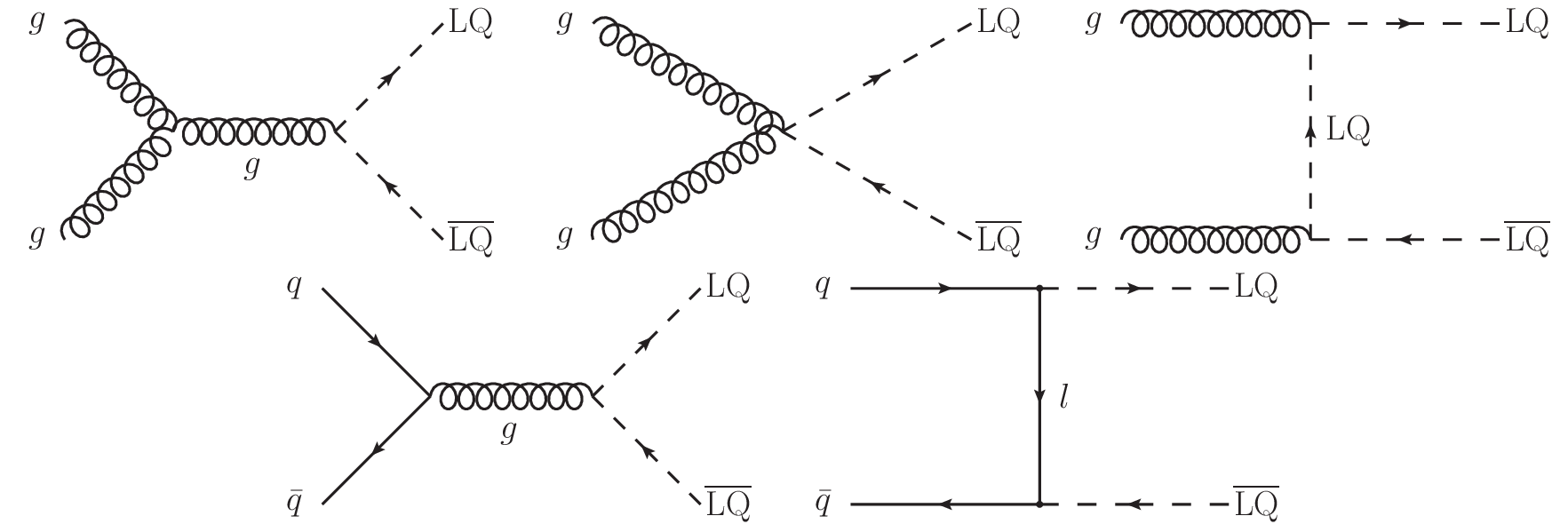
png pdf |
Figure 1:
Dominant leading-order diagrams for the pair production of scalar leptoquarks. |
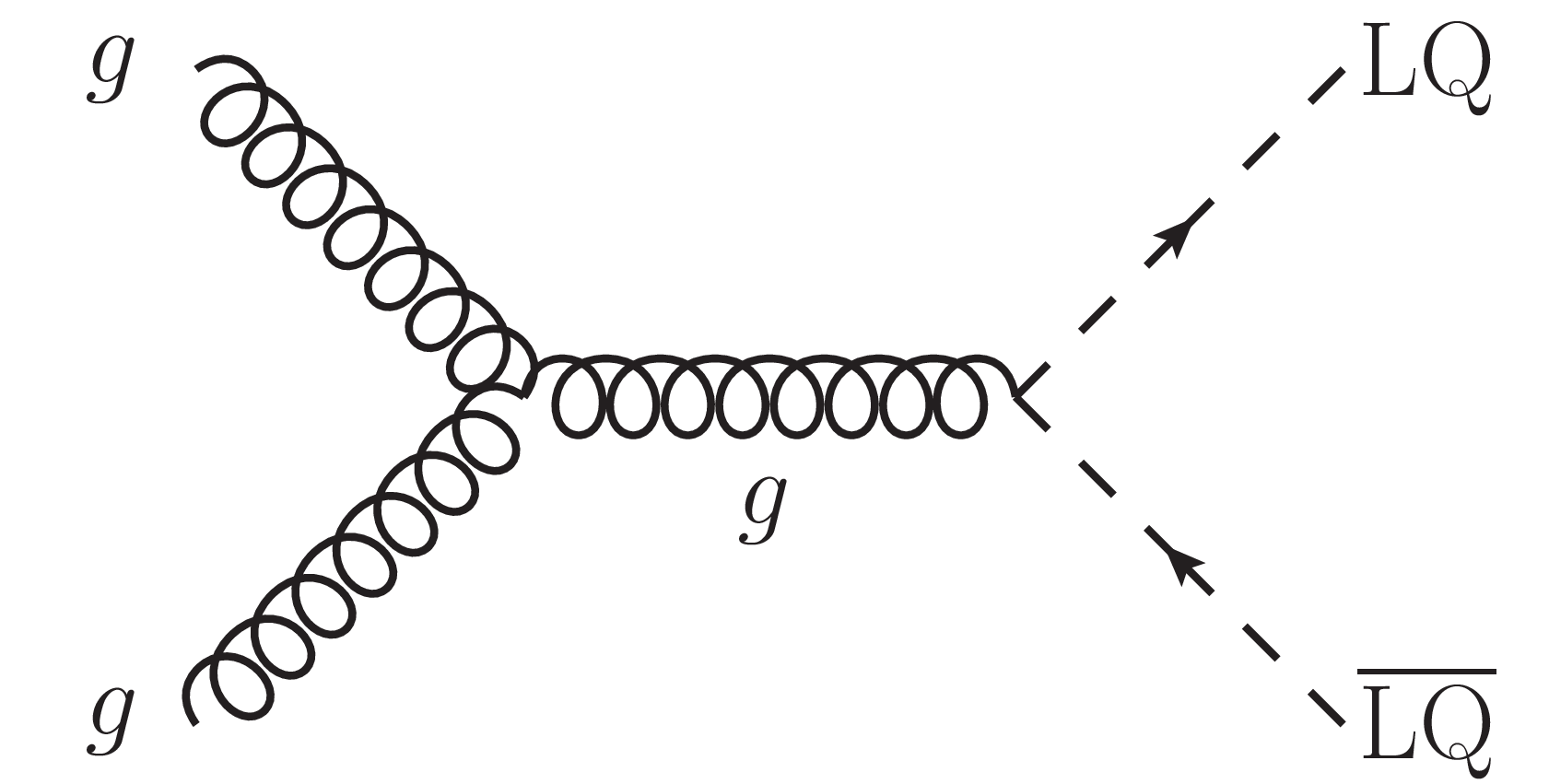
png pdf |
Figure 1-a:
Dominant leading-order diagram for the pair production of scalar leptoquarks. |
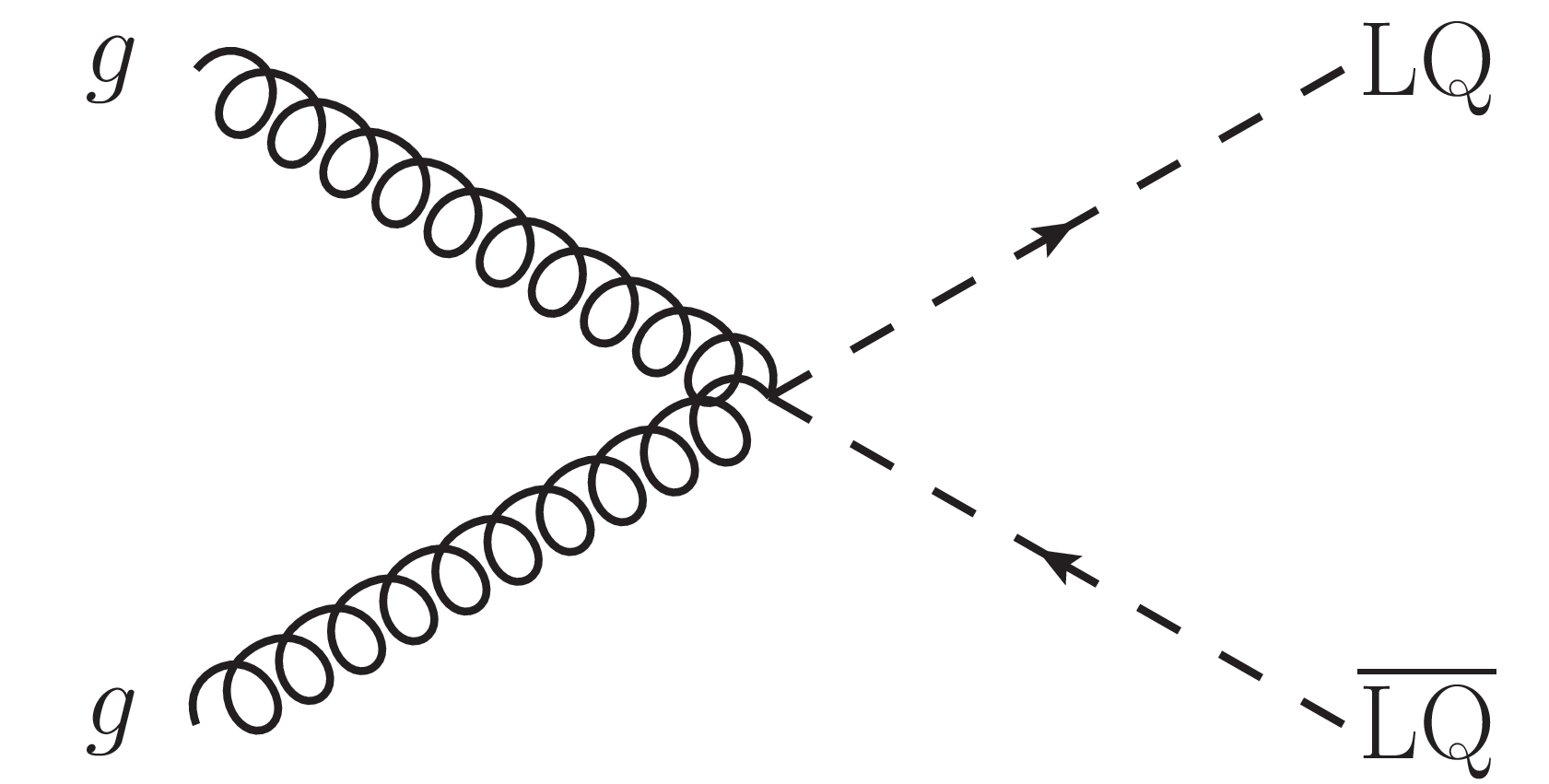
png pdf |
Figure 1-b:
Dominant leading-order diagram for the pair production of scalar leptoquarks. |
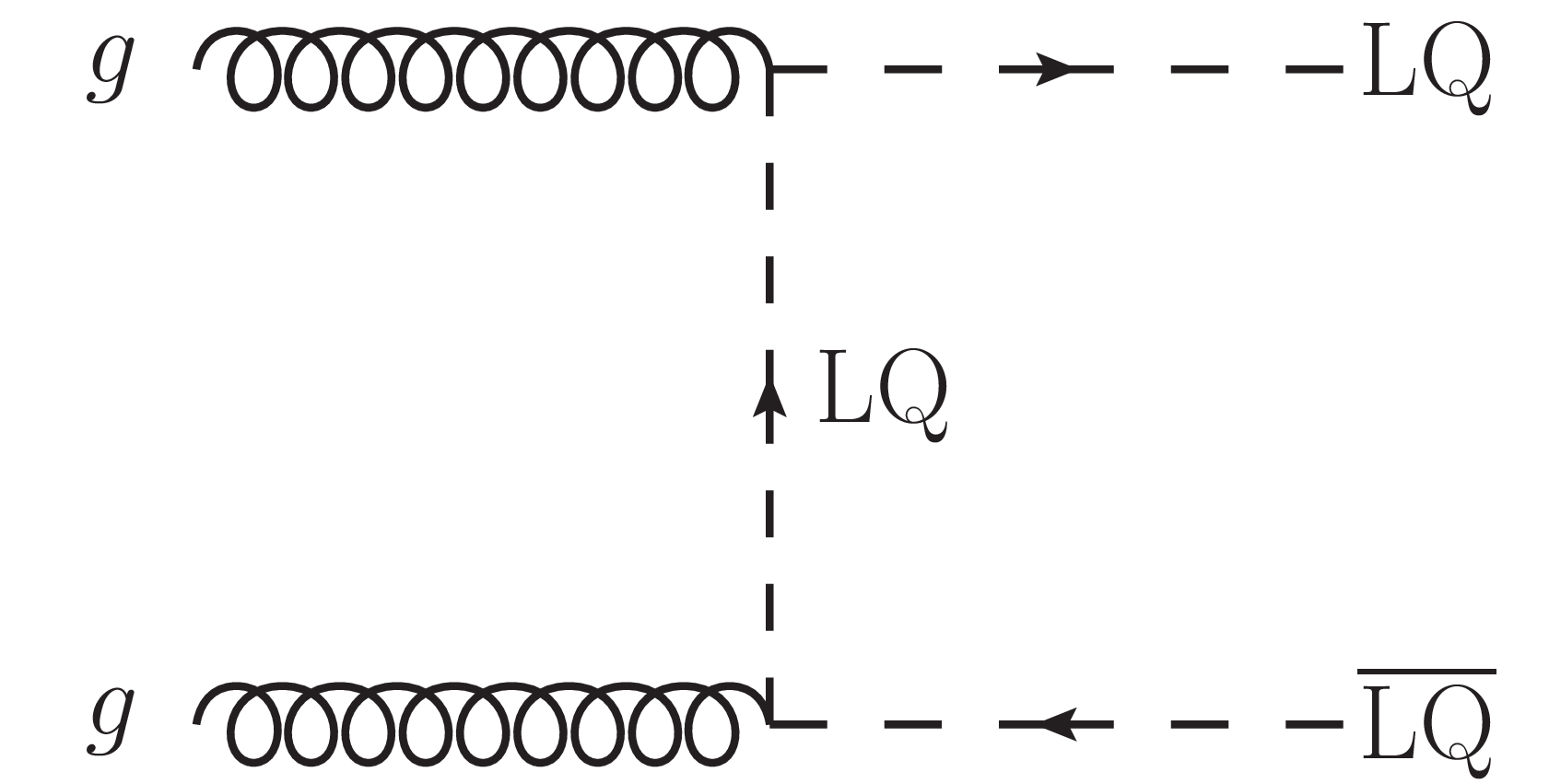
png pdf |
Figure 1-c:
Dominant leading-order diagram for the pair production of scalar leptoquarks. |
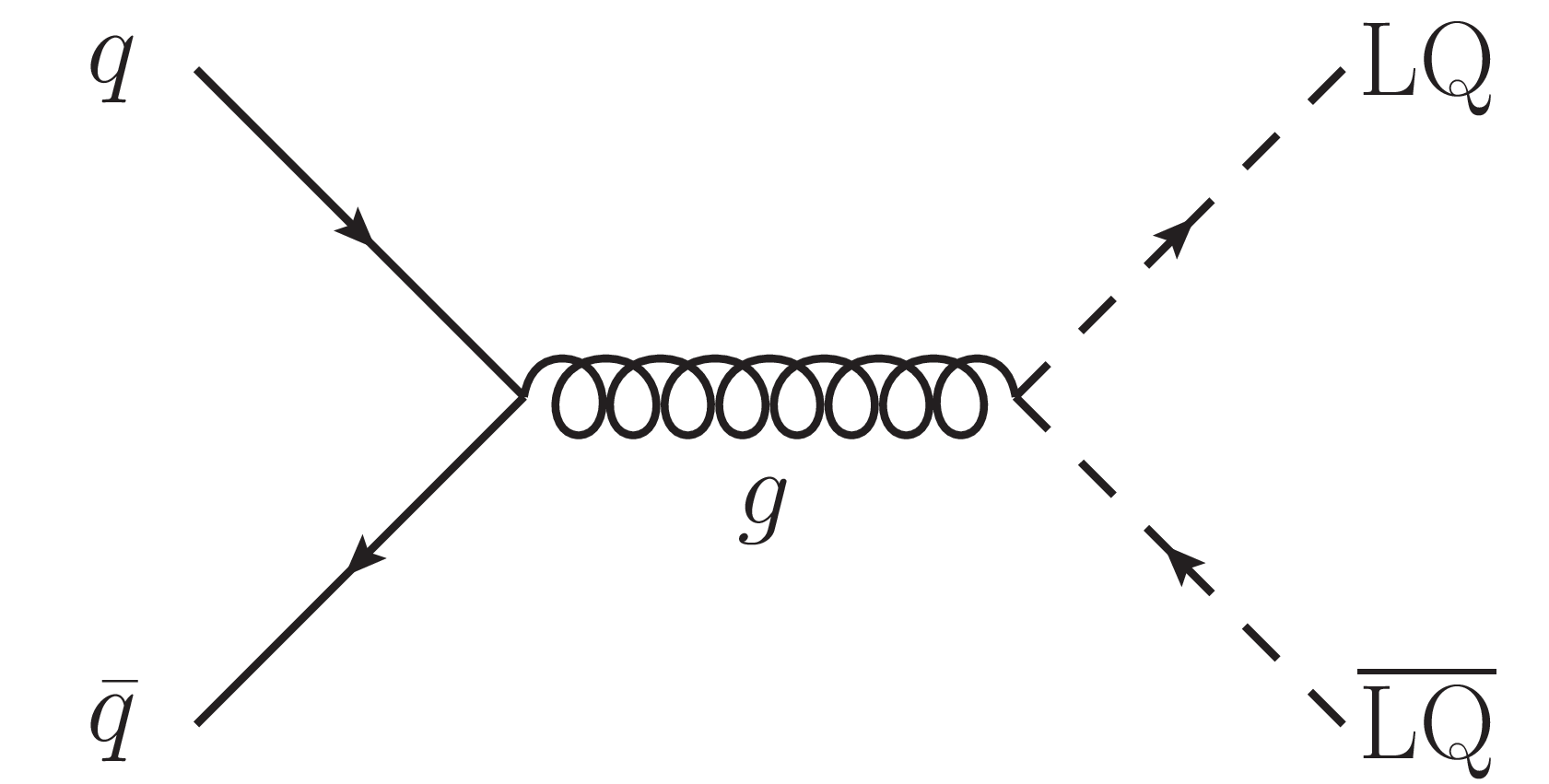
png pdf |
Figure 1-d:
Dominant leading-order diagram for the pair production of scalar leptoquarks. |
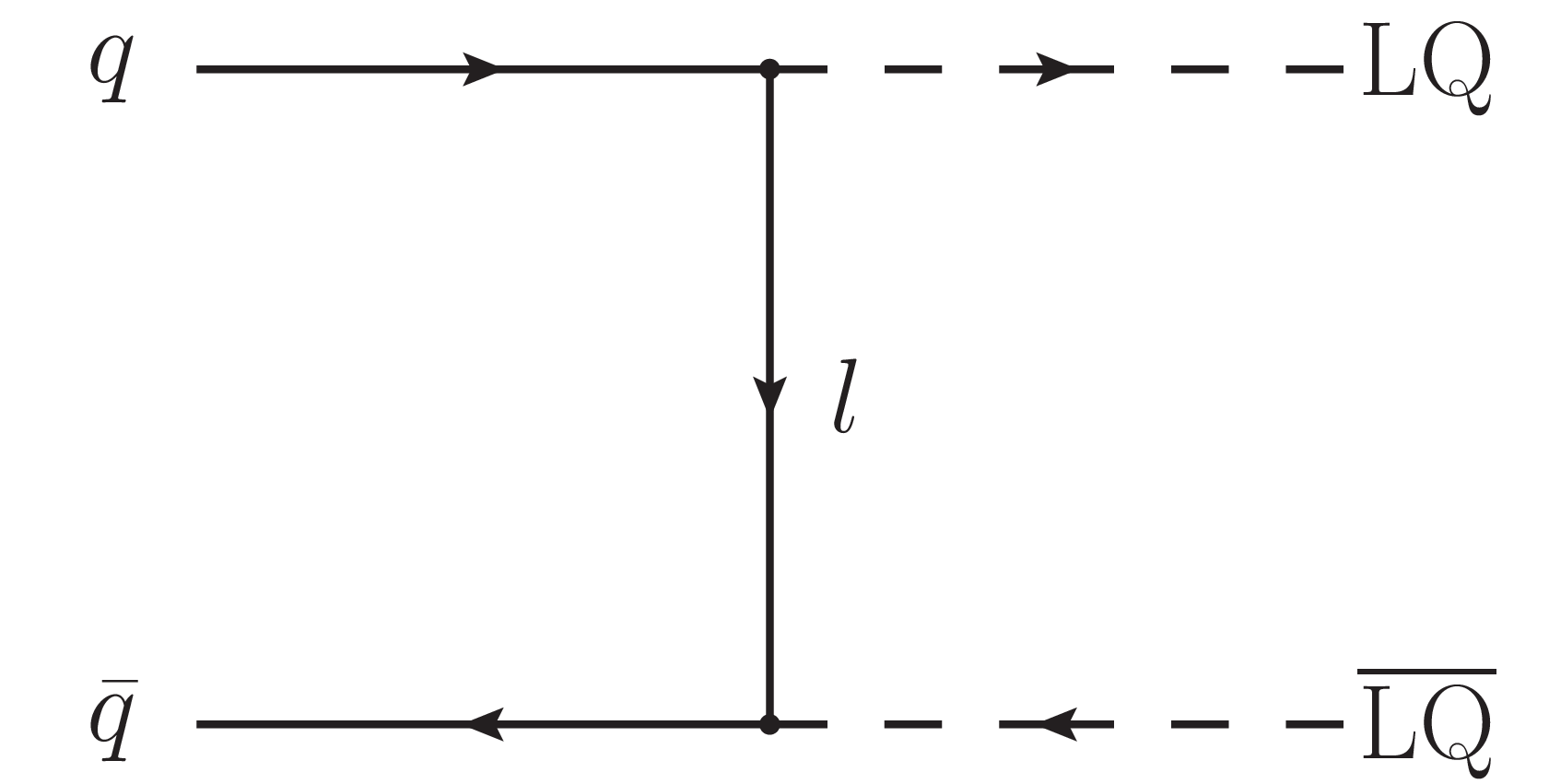
png pdf |
Figure 1-e:
Dominant leading-order diagram for the pair production of scalar leptoquarks. |
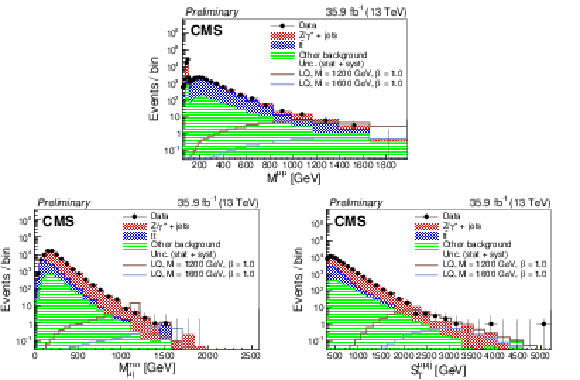
png pdf |
Figure 2:
Data and background comparison at preselection level for the $ {\mu} {\mu} \mathrm {jj}$ channel, shown for the variables used for final selection cut optimization M$_{{\mu} {\mu}}$ (top), M$_{{\mu} \mathrm {j}}^{\mathrm {min}}$ (bottom left), and S$_{\mathrm {T}}^{{\mu} {\mu} \mathrm {jj}}$ (bottom right). |
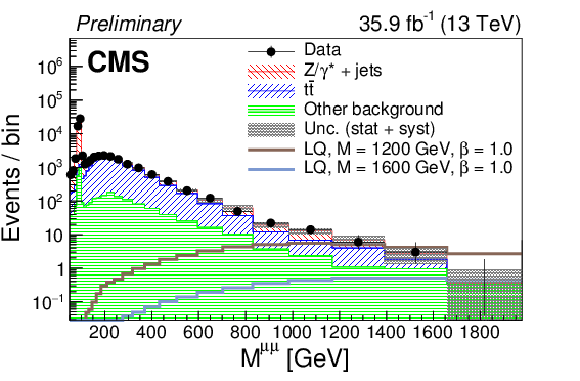
png pdf |
Figure 2-a:
Data and background comparison at preselection level for the $ {\mu} {\mu} \mathrm {jj}$ channel, shown for a variable used for final selection cut optimization, M$_{{\mu} {\mu}}$. |
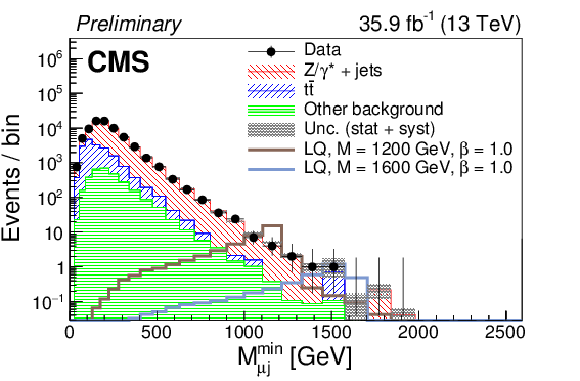
png pdf |
Figure 2-b:
Data and background comparison at preselection level for the $ {\mu} {\mu} \mathrm {jj}$ channel, shown for a variable used for final selection cut optimization, M$_{{\mu} \mathrm {j}}^{\mathrm {min}}$. |
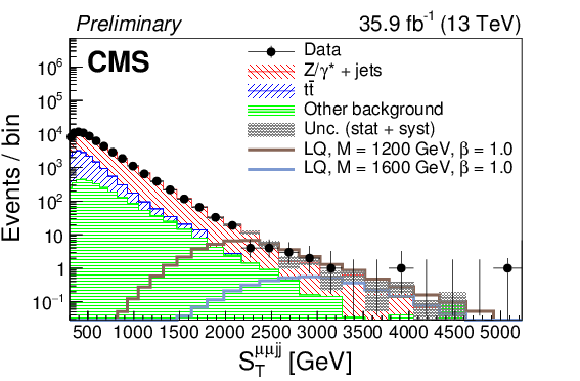
png pdf |
Figure 2-c:
Data and background comparison at preselection level for the $ {\mu} {\mu} \mathrm {jj}$ channel, shown for a variable used for final selection cut optimization, S$_{\mathrm {T}}^{{\mu} {\mu} \mathrm {jj}}$. |

png pdf |
Figure 3:
Data and background comparison at preselection level for the $ {\mu} {\nu}\mathrm {jj}$ channel, shown for the variables used for final selection cut optimization M$_{\mathrm {T}}^{{\mu} {\nu}}$ (top), M$_{{\mu} \mathrm {j}}$ (bottom left), and S$_{\mathrm {T}}^{{\mu} {\nu}\mathrm {jj}}$ (bottom right). |
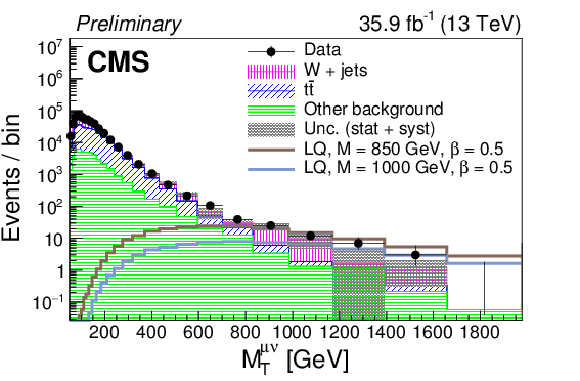
png pdf |
Figure 3-a:
Data and background comparison at preselection level for the $ {\mu} {\nu}\mathrm {jj}$ channel, shown for a variable used for final selection cut optimization, M$_{\mathrm {T}}^{{\mu} {\nu}}$ (top). |
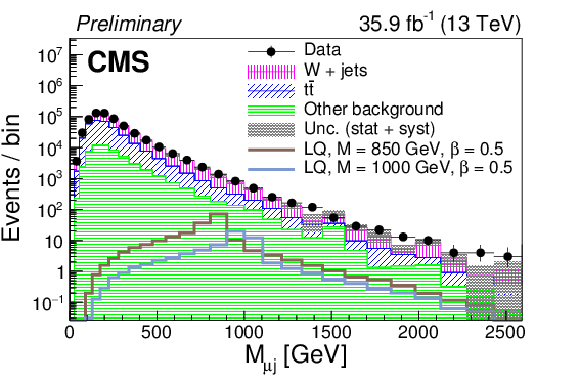
png pdf |
Figure 3-b:
Data and background comparison at preselection level for the $ {\mu} {\nu}\mathrm {jj}$ channel, shown for a variable used for final selection cut optimization, M$_{{\mu} \mathrm {j}}$. |
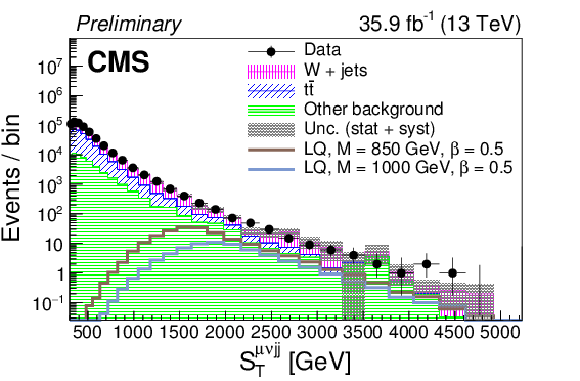
png pdf |
Figure 3-c:
Data and background comparison at preselection level for the $ {\mu} {\nu}\mathrm {jj}$ channel, shown for a variable used for final selection cut optimization, S$_{\mathrm {T}}^{{\mu} {\nu}\mathrm {jj}}$. |
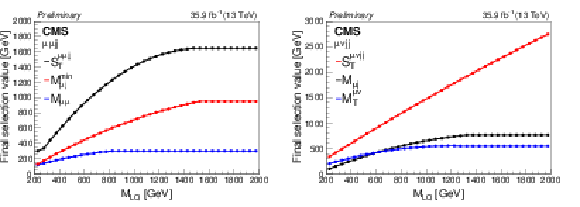
png pdf |
Figure 4:
Final selection cuts for the three variables for both the $ {\mu} {\mu} \mathrm {jj}$ (left) and $ {\mu} {\nu}\mathrm {jj}$ (right) channels as a function of LQ mass. |
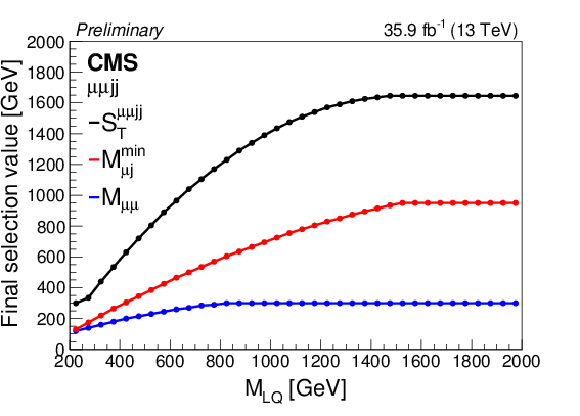
png pdf |
Figure 4-a:
Final selection cuts for the three variables for the $ {\mu} {\mu} \mathrm {jj}$ channel as a function of LQ mass. |
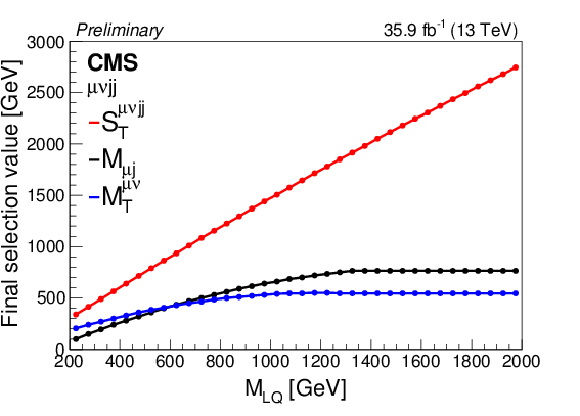
png pdf |
Figure 4-b:
Final selection cuts for the three variables for the $ {\mu} {\nu}\mathrm {jj}$ channel as a function of LQ mass. |
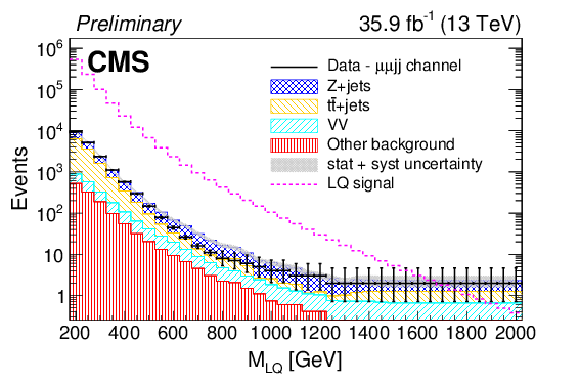
png pdf |
Figure 5:
Data and background event yields at final selection level for the $ \mu \mu \mathrm{jj} $ analysis, as a function of leptoquark mass. 'Other background' includes W+jets and single top. The samples in individual bins are largely overlapping. |
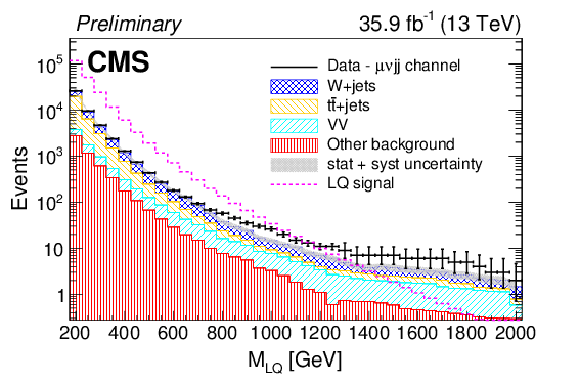
png pdf |
Figure 6:
Data and background event yields at final selection level for the $ \mu \nu \mathrm{jj} $ analysis, as a function of leptoquark mass. 'Other background' includes Z+jets and single top. The samples in individual bins are largely overlapping. |
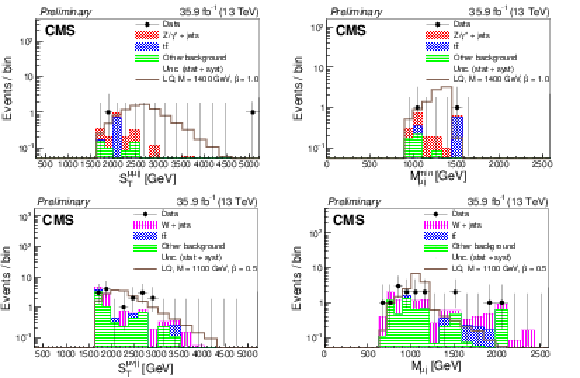
png pdf |
Figure 7:
Data and background comparison at final selection level for $\mathrm {M}_{\mathrm {LQ}}= $ 1400 GeV for the $ {\mu} {\mu} \mathrm {jj}$ (top) and for $\mathrm {M}_{\mathrm {LQ}}= $ 1100 GeV for the $ {\mu} {\nu}\mathrm {jj}$ (bottom) channel, shown for S$_{\mathrm {T}}$ (left) and LQ invariant mass (right). |
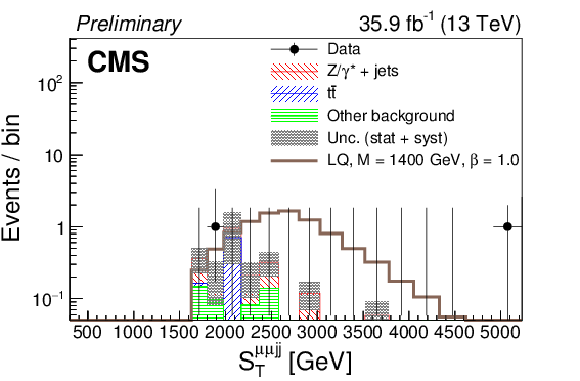
png pdf |
Figure 7-a:
Data and background comparison at final selection level for $\mathrm {M}_{\mathrm {LQ}}= $ 1400 GeV for the $ {\mu} {\mu} \mathrm {jj}$ channel, shown for S$_{\mathrm {T}}$. |
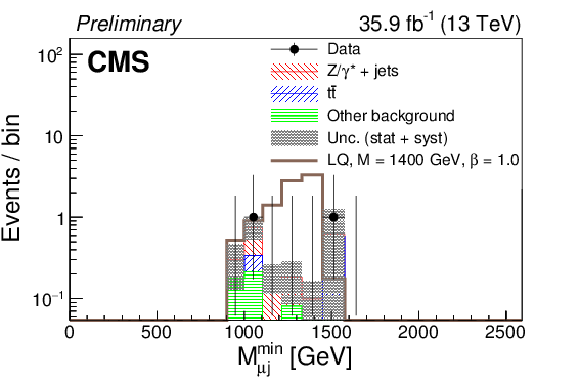
png pdf |
Figure 7-b:
Data and background comparison at final selection level for $\mathrm {M}_{\mathrm {LQ}}= $ 1400 GeV for the $ {\mu} {\mu} \mathrm {jj}$ channel, shown for LQ invariant mass. |
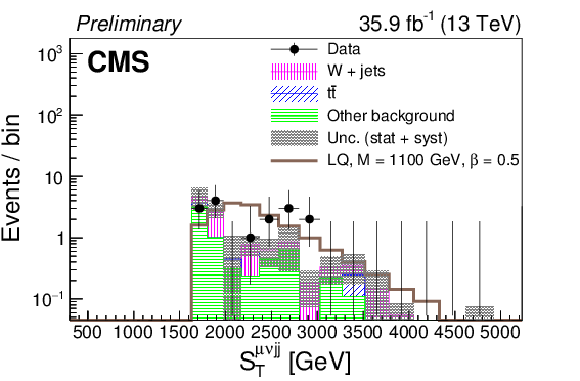
png pdf |
Figure 7-c:
Data and background comparison at final selection level for $\mathrm {M}_{\mathrm {LQ}}= $ 1100 GeV for the $ {\mu} {\nu}\mathrm {jj}$ channel, shown for S$_{\mathrm {T}}$. |
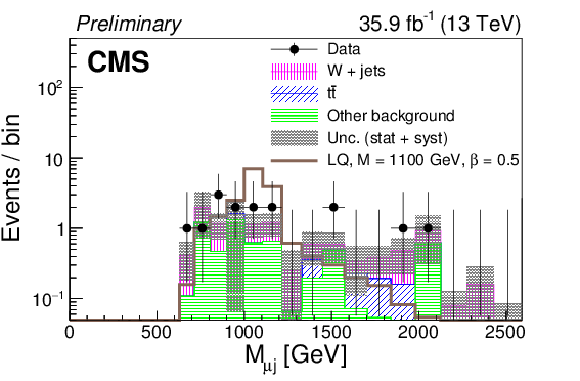
png pdf |
Figure 7-d:
Data and background comparison at final selection level for $\mathrm {M}_{\mathrm {LQ}}= $ 1100 GeV for the $ {\mu} {\nu}\mathrm {jj}$ channel, shown for LQ invariant mass. |
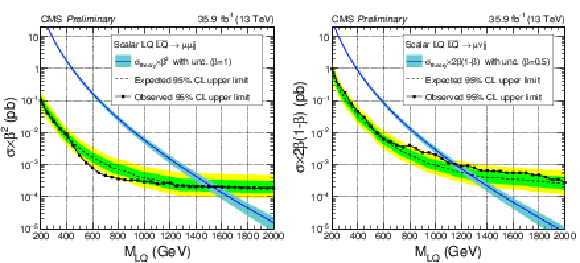
png pdf |
Figure 8:
The expected and observed upper limits at 95% CL on the leptoquark pair production cross section times $\beta ^2$ ($2\beta (1-\beta)$) as a function of the second-generation leptoquark mass obtained with the $ \mu \mu \mathrm{jj} $ (left) and $ \mu \nu \mathrm{jj} $ (right) analysis. The solid lines represent the observed limits, the dashed lines represent the median expected limits, and the colored bands represent the 68% and 95% confidence intervals. The $\sigma _{\rm theory}$ curves and their bands represent, respectively, the theoretical scalar leptoquark pair production cross section and the uncertainties due to the choice of PDF and renormalization/factorization scales. |
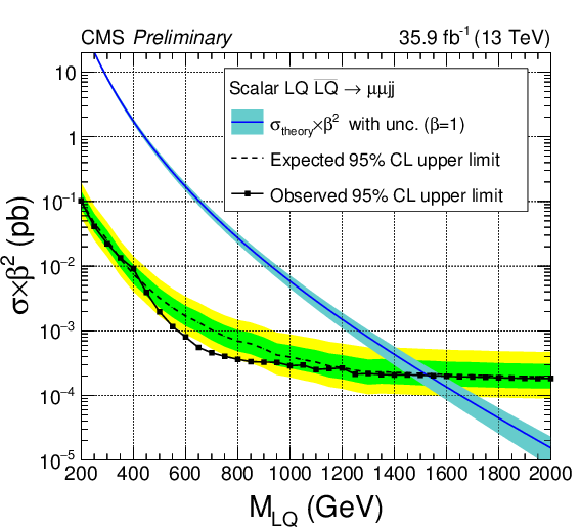
png pdf |
Figure 8-a:
The expected and observed upper limits at 95% CL on the leptoquark pair production cross section times $\beta ^2$ ($2\beta (1-\beta)$) as a function of the second-generation leptoquark mass obtained with the $ \mu \mu \mathrm{jj} $ analysis. The solid lines represent the observed limits, the dashed lines represent the median expected limits, and the colored bands represent the 68% and 95% confidence intervals. The $\sigma _{\rm theory}$ curves and their bands represent, respectively, the theoretical scalar leptoquark pair production cross section and the uncertainties due to the choice of PDF and renormalization/factorization scales. |
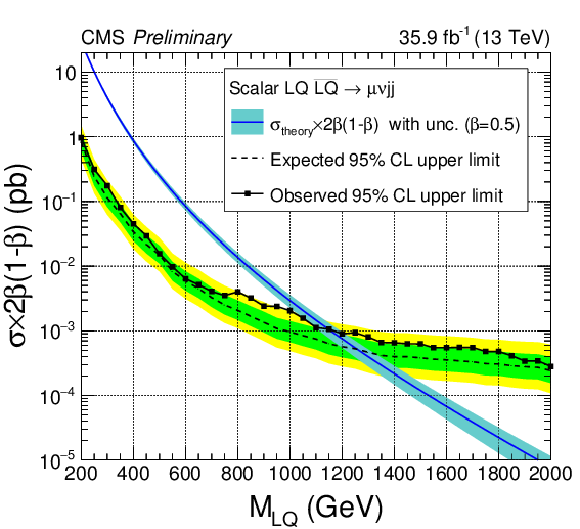
png pdf |
Figure 8-b:
The expected and observed upper limits at 95% CL on the leptoquark pair production cross section times $\beta ^2$ ($2\beta (1-\beta)$) as a function of the second-generation leptoquark mass obtained with the $ \mu \nu \mathrm{jj} $ analysis. The solid lines represent the observed limits, the dashed lines represent the median expected limits, and the colored bands represent the 68% and 95% confidence intervals. The $\sigma _{\rm theory}$ curves and their bands represent, respectively, the theoretical scalar leptoquark pair production cross section and the uncertainties due to the choice of PDF and renormalization/factorization scales. |
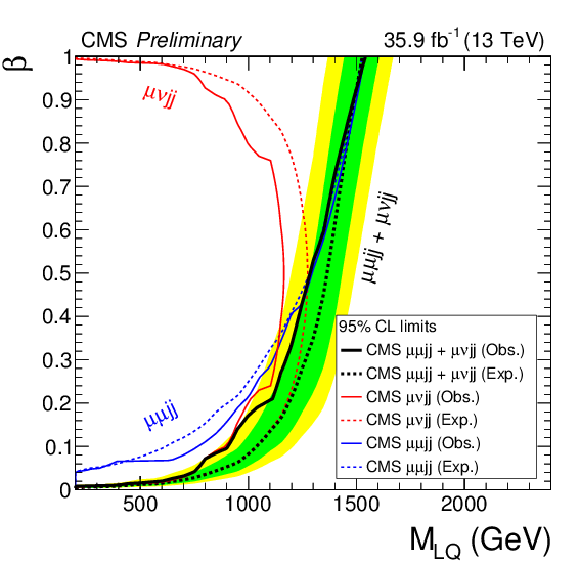
png pdf |
Figure 9:
The expected and observed exclusion limits at 95% CL for second-generation leptoquark mass as a function of the branching fraction $\beta $ vs. LQ mass M$_\mathrm {LQ}$. The dark green and light yellow expected limit uncertainty bands represent the 68% and 95% confidence intervals on the combination. Limits for the individual $ \mu \mu \mathrm{jj} $ and $ \mu \nu \mathrm{jj} $ channels are also given. Solid lines represent the observed limits in each channel, and dashed lines represent the expected limits. |
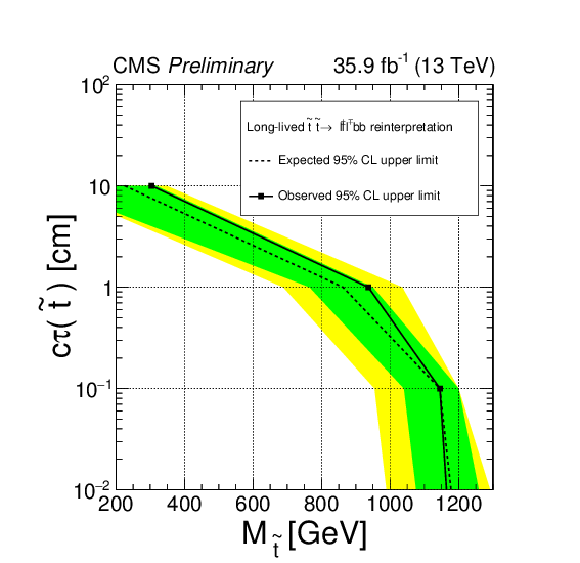
png pdf |
Figure 10:
Expected and observed upper limits at 95% CL on the long-lived RPV SUSY $\tilde{t}$ pair production cross section as a function of $\tilde{t}$ mass (x-axis) and lifetime (y-axis). The expected limits and uncertainty bands represent the median expected limits and the 68% and 95% confidence intervals. Extrapolation has been performed to produce a limit plot down to the prompt kinematic range. |

png pdf |
Figure 11:
Signal acceptance*efficiency for optimized final selections as a function of scalar LQ mass in the $ {\mu} {\mu} \mathrm {jj}$ (left) and $ {\mu} {\nu}\mathrm {jj}$ (right) channels. |
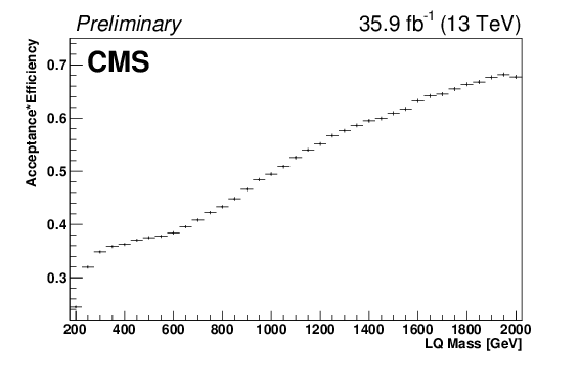
png pdf |
Figure 11-a:
Signal acceptance*efficiency for optimized final selections as a function of scalar LQ mass in the $ {\mu} {\nu}\mathrm {jj}$ channel. |
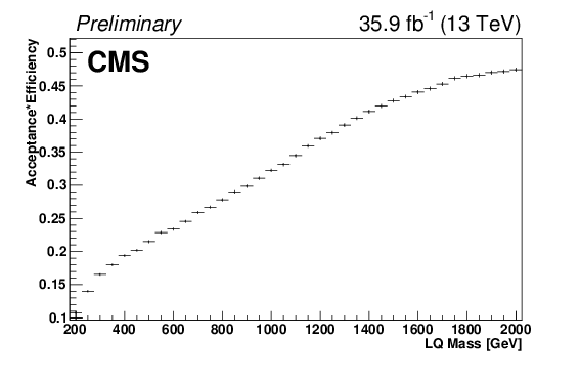
png pdf |
Figure 11-b:
Signal acceptance*efficiency for optimized final selections as a function of scalar LQ mass in the $ {\mu} {\mu} \mathrm {jj}$ channel. |
| Tables | |

png pdf |
Table 1:
Range of systematic uncertainties on the signal acceptance and background (BG) yields for the $ {\mu} {\mu} \mathrm {jj}$ analysis. The last two lines show the total systematic uncertainty, and the total statistical uncertainty of the simulated samples, respectively. |
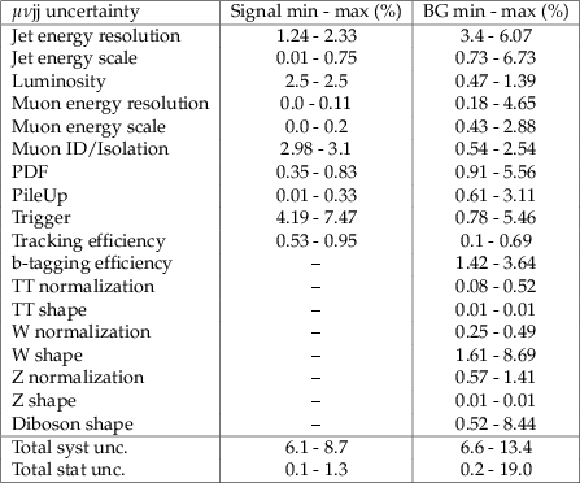
png pdf |
Table 2:
Range of systematic uncertainties on the signal acceptance and background (BG) yields for the $ {\mu} {\nu}\mathrm {jj}$ analysis. The last two lines show the total systematic uncertainty, and the total statistical uncertainty of the simulated samples, respectively. |
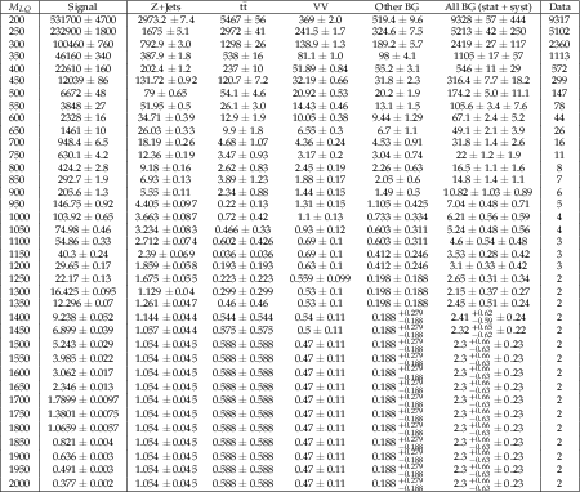
png pdf |
Table 3:
Event yields at final selection level for the $ \mu \mu \mathrm{jj} $ analysis. 'Other BG' includes W+jets and single top. Uncertainties are statistical unless otherwise indicated. |
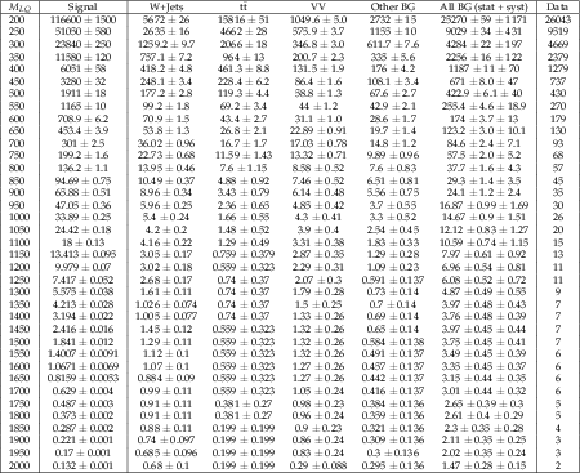
png pdf |
Table 4:
Event yields at final selection level for the $ \mu \nu \mathrm{jj} $ analysis. 'Other BG' includes Z+jets and single top.Uncertainties are statistical unless otherwise indicated. |
| Summary |
| A search has been performed for pair production of second-generation leptoquarks using 35.9 fb$^{-1}$ of proton-proton collisions collected at $\sqrt{s}$=13 TeV in 2016 with the CMS detector at the CERN LHC. Limits have been set on pair production in the $ \mu \mu \mathrm{jj} $ ($ \mu \nu \mathrm{jj} $) channels for $\beta$ = 1 (0.5) as a function of leptoquark mass. Two-dimensional limits have also been set in the $\beta$ - leptoquark mass plane. The $ \mu \mu \mathrm{jj} $ search has been reinterpreted in the context of a displaced SUSY model. These limits represent the most stringent limits to date on these models. |
| References | ||||
| 1 | J. C. Pati and A. Salam | Unified lepton-hadron symmetry and a gauge theory of the basic interactions | PRD 8 (1973) 1240 | |
| 2 | J. C. Pati and A. Salam | Lepton number as the fourth color | PRD 10 (1974) 275 | |
| 3 | H. Georgi and S. Glashow | Unity of all elementary-particle forces | PRL 32 (1974) 438 | |
| 4 | H. Murayama and T. Yanagida | A viable SU(5) GUT with light leptoquark bosons | MPLA 7 (1992) 147 | |
| 5 | H. Fritzsch and P. Minkowski | United interactions of leptons and hadrons | Annals Phys. 93 (1975) 193 | |
| 6 | G. Senjanovi\'c and A. Sokorac | Light lepto-quarks in SO(10) | Z. Phys. C 20 (1983) 255 | |
| 7 | P. H. Frampton and B.-H. Lee | SU(15) Grand Unification | PRL 64 (1990) 619 | |
| 8 | P. H. Frampton and T. W. Kephart | Higgs Sector and Proton Decay in SU(15q) Grand Unification | PRD 42 (1990) 3892 | |
| 9 | B. Schrempp and F. Schrempp | Light leptoquarks | PLB 153 (1985) 101 | |
| 10 | S. Dimopoulos and L. Susskind | Mass without scalars | NPB 155 (1979) 237 | |
| 11 | S. Dimopoulos | Technicolored signatures | NPB 168 (1980) 69 | |
| 12 | E. Eichten and K. Lane | Dynamical breaking of the weak interaction symmetries | PLB 90 (1980) 85 | |
| 13 | J. L. Hewett and T. G. Rizzo | Low-energy phenomenology of superstring-inspired E$ _{6} $ models | PL183 (1989) 193 | |
| 14 | Belle Collaboration | Observation of B0$ \rightarrow $D*- $ \tau^{+}\nu_\tau $ decay at Belle | PRL 99 (2007) 191807 | 0706.4429 |
| 15 | Belle Collaboration | Observation of B$ ^{+}\rightarrow \overline{D} $*0$ \tau^{+}\nu_\tau $ and Evidence for B$ ^{+}\rightarrow\overline{D}^0\tau^+\nu_\tau $ at Belle | PRD82 (2010) 072005 | 1005.2302 |
| 16 | Belle Collaboration | Measurement of the branching ratio of $ \bar{B} \to D^{(\ast)} \tau^- \bar{\nu}_\tau $ relative to $ \bar{B} \to D^{(\ast)} \ell^- \bar{\nu}_\ell $ decays with hadronic tagging at Belle | PRD92 (2015), no. 7, 072014 | 1507.03233 |
| 17 | BaBar Collaboration | Evidence for an excess of $ \bar{B} \to D^{(*)} \tau^-\bar{\nu}_\tau $ decays | PRL 109 (2012) 101802 | 1205.5442 |
| 18 | BaBar Collaboration | Measurement of an Excess of $ \bar{B} \to D^{(*)}\tau^- \bar{\nu}_\tau $ Decays and Implications for Charged Higgs Bosons | PRD88 (2013), no. 7, 072012 | 1303.0571 |
| 19 | LHCb Collaboration | Measurement of the ratio of branching fractions $ \mathcal{B}(\bar{B}^0 \to D^{*+}\tau^{-}\bar{\nu}_{\tau})/\mathcal{B}(\bar{B}^0 \to D^{*+}\mu^{-}\bar{\nu}_{\mu}) $ | PRL 115 (2015), no. 11, 111803 | 1506.08614 |
| 20 | LHCb Collaboration | Measurement of Form-Factor-Independent Observables in the Decay $ B^{0} \to K^{*0} \mu^+ \mu^- $ | PRL 111 (2013) 191801 | 1308.1707 |
| 21 | LHCb Collaboration | Test of lepton universality using $ B^{+}\rightarrow K^{+}\ell^{+}\ell^{-} $ decays | PRL 113 (2014) 151601 | 1406.6482 |
| 22 | H. K. Dreiner | An introduction to explicit $ R $-parity violation | Pramana 51 (1998) 123 | |
| 23 | P. W. Graham, D. E. Kaplan, S. Rajendran, and P. Saraswat | Displaced supersymmetry | Journal of High Energy Physics 2012 (2012), no. 7, 1 | |
| 24 | CMS Collaboration | The cms experiment at the cern lhc | JINST 3 (2008) S08004 | CMS-00-001 |
| 25 | CMS Collaboration | CMS Luminosity Measurement for the 2015 Data Taking Period | CMS-PAS-LUM-15-001 | CMS-PAS-LUM-15-001 |
| 26 | NNPDF Collaboration | Parton distributions for the LHC Run II | JHEP 04 (2015) 040 | 1410.8849 |
| 27 | GEANT4 Collaboration | GEANT4: A simulation toolkit | NIMA506 (2003) 250--303 | |
| 28 | J. Allison et al. | Geant4 developments and applications | IEEE Trans. Nucl. Sci. 53 (2006) 270 | |
| 29 | T. Sjostrand et al. | High-energy-physics event generation with pythia 6.1 | Comp. Phys. Comm. 135 (2001) 238 | |
| 30 | T. Sjostrand, S. Mrenna, and P. Z. Skands | A Brief Introduction to PYTHIA 8.1 | CPC 178 (2008) 852 | 0710.3820 |
| 31 | J. Pumplin et al. | New generation of parton distributions with uncertainties from global QCD analysis | JHEP 07 (2002) 012 | |
| 32 | W. Beenakker et al. | Stop production at hadron colliders | NPB 515 (1998) 3 | hep-ph/9710451 |
| 33 | W. Beenakker et al. | Supersymmetric top and bottom squark production at hadron colliders | JHEP 08 (2010) 098 | 1006.4771 |
| 34 | W. Beenakker et al. | Squark and Gluino Hadroproduction | Int. J. Mod. Phys. A 26 (2011) 2637 | 1105.1110 |
| 35 | J. Alwall et al. | The automated computation of tree-level and next-to-leading order differential cross sections, and their matching to parton shower simulations | JHEP 07 (2014) 079 | 1405.0301 |
| 36 | S. Frixione and B. R. Webber | Matching NLO QCD computations and parton shower simulations | JHEP 06 (2002) 029 | hep-ph/0204244 |
| 37 | S. Frixione, P. Nason, and C. Oleari | Matching NLO QCD computations with parton shower simulations: the POWHEG method | JHEP 11 (2007) 070 | 0709.2092 |
| 38 | S. Alioli, P. Nason, C. Oleari, and E. Re | A general framework for implementing NLO calculations in shower Monte Carlo programs: the POWHEG BOX | JHEP 06 (2010) 043 | 1002.2581 |
| 39 | S. Alioli, P. Nason, C. Oleari, and E. Re | NLO vector-boson production matched with shower in POWHEG | JHEP 07 (2008) 060 | |
| 40 | R. Gavin, Y. Li, F. Petriello, S. Quackenbush | FEWZ 2.0: A code for hadronic Z production at next-to-next-to-leading order | 1011.3540 | |
| 41 | J. Campbell, R. K. Ellis, and F. Tramontano | Single top-quark production and decay at next-to-leading order | PRD 70 (2004) 094012 | hep-ph/0408158 |
| 42 | J. Campbell and F. Tramontano | Next-to-leading order corrections to Wt production and decay | NPB 726 (2005) 109 | hep-ph/0506289 |
| 43 | J. M. Campbell, R. Frederix, F. Maltoni, and F. Tramontano | Next-to-leading-order predictions for $ t $-channel single-top production at hadron colliders | PRL 102 (2009) 182003 | 0903.0005 |
| 44 | J. M. Campbell, R. K. Ellis, and C. Williams | Vector boson pair production at the LHC | JHEP 07 (2011) 018 | 1105.0020 |
| 45 | M. Czakon, P. Fiedler, and A. Mitov | The total top quark pair production cross-section at hadron colliders through O($ \alpha_S^4 $) | PRL 110 (2013) 252004 | 1303.6254 |
| 46 | M. Czakon, M. L. Mangano, A. Mitov, and J. Rojo | Constraints on the gluon PDF from top quark pair production at hadron colliders | JHEP 07 (2013) 167 | 1303.7215 |
| 47 | CMS Collaboration | Particle-flow reconstruction and global event description with the cms detector | JINST 12 (2017) P10003 | CMS-PRF-14-001 1706.04965 |
| 48 | M. Cacciari, G. P. Salam, and G. Soyez | The anti-kt jet clustering algorithm | JHEP 2008 (2008) 063 | |
| 49 | M. Cacciari, G. P. Salam, and G. Soyez | FastJet user manual | EPJC 72 (2012) 1896 | 1111.6097 |
| 50 | CMS Collaboration | Performance of CMS muon reconstruction in pp collision events at $ \sqrt{s}= $ 7 TeV | JINST 7 (2012) 10002 | CMS-MUO-10-004 1206.4071 |
| 51 | CMS Collaboration | Performance of electron reconstruction and selection with the CMS detector in proton-proton collisions at $ \sqrt{s} = $ 8 TeV | JINST 10 (2015) P06005 | CMS-EGM-13-001 1502.02701 |
| 52 | G. Punzi | Sensitivity of searches for new signals and its optimization | eConf C030908 (2003) MODT002, [,79(2003)] | physics/0308063 |
| 53 | CMS Collaboration | Identification of heavy-flavour jets with the CMS detector in pp collisions at 13 TeV | Submitted to \it JINST | CMS-BTV-16-002 1712.07158 |
| 54 | T. Junk | Confidence level computation for combining searches with small statistics | Nucl.Instrum.Meth. A434 (1999) 435 | hep-ex/9902006 |
| 55 | A. L. Read | Modified frequentist analysis of search results (the $ CL_{s} $ method) | CERN-OPEN-2000-205 (2000) | |
| 56 | ATLAS and CMS Collaborations | Procedure for the LHC Higgs boson search combination in summer 2011 | CMS-NOTE-2011-005 | |

|
Compact Muon Solenoid LHC, CERN |

|

|

|

|

|

|